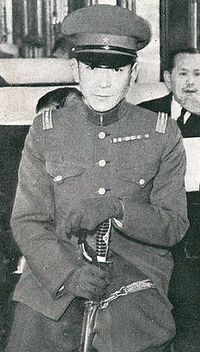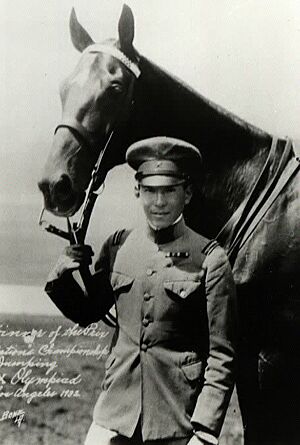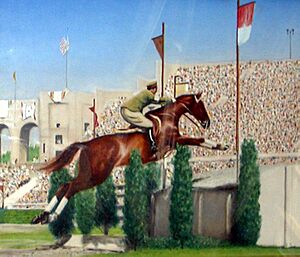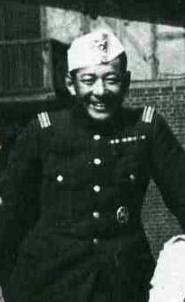Takeichi Nishi facts for kids
Quick facts for kids
Takeichi Nishi
|
|
|---|---|
 |
|
| Native name |
西 竹一
|
| Nickname(s) | Baron Nishi |
| Born | July 12, 1902 Azabu, Tokyo, Japan |
| Died | March 22, 1945 (aged 42) Iwo Jima, Japan |
| Allegiance | Empire of Japan |
| Service/ |
Imperial Japanese Army |
| Years of service | 1924–1945 |
| Rank | Colonel (posthumous) |
| Commands held | 26th Tank Regiment, Mudanjiang |
| Battles/wars | |
| Relations | Son of Nishi Tokujirō |
Takeichi Nishi was a Japanese Army officer and an amazing horse rider. He was also known as Baron Nishi. He won a gold medal in horse riding at the 1932 Summer Olympics in Los Angeles. Later, he became a tank commander during World War II. He bravely fought and died during the Battle of Iwo Jima.
Contents
Who Was Takeichi Nishi?
Growing Up in Japan
Takeichi Nishi was born in Azabu, Tokyo, Japan, on July 12, 1902. He was the third son of Tokujirō Nishi, who was a baron. A baron was a special noble title in Japan at that time. His father worked in important government jobs, even serving as an ambassador.
When he was 10 years old, Takeichi became a baron himself after his father passed away. He went to good schools, including Tokyo First Junior High School. He was a bright student.
Becoming a Soldier
In 1917, Nishi started his military training at Hiroshima Army Cadet School. This school was like a special high school for future soldiers. He then went to the Imperial Japanese Army Academy.
He joined the First Cavalry Regiment, which was a unit that rode horses. In 1924, he finished his studies and became a second lieutenant. He loved horses and continued his training at the Army Cavalry School.
Olympic Dreams and Gold
His Special Horse: Uranus
In 1930, while in Italy, Nishi met a horse named Uranus. He loved Uranus so much that he bought the horse with his own money. The army would not pay for it. Nishi and Uranus became a great team. They competed in horse riding events all over Europe.
Winning Gold in Los Angeles
| Olympic medal record | ||
|---|---|---|
| Equestrian | ||
| Gold | 1932 Los Angeles | Individual show jumping |
In 1932, Nishi and Uranus went to the 1932 Summer Olympics in Los Angeles, USA. They competed in the individual show jumping event. This is where horses and riders jump over obstacles. They won the gold medal!
This was a huge achievement. It was Japan's only Olympic medal ever in a horse riding event. People in America called him "Baron Nishi." He was very popular, even hanging out with famous movie stars like Charlie Chaplin.
The 1936 Olympics
Nishi and Uranus also competed in the 1936 Summer Olympics in Berlin, Germany. However, Nishi fell off his horse during the competition. They did not win a medal that time.
From Cavalry to Tanks
A Change in the Army
After the Olympics, the Japanese Army started to change. They used fewer cavalry (horse-riding) units and more tank regiments. Nishi, who was a major by 1939, was moved to lead the 26th Tank Regiment. This unit was based in northern Manchukuo, a region in China.
Journey to Iwo Jima
In 1944, Nishi's tank regiment was ordered to go to Iwo Jima. This was a small island that Japan needed to defend during World War II. On the way, the ship carrying his tanks was hit by torpedoes from an American submarine. Most of his tanks were lost.
Nishi went back to Tokyo to get new tanks. While there, he visited his beloved horse, Uranus. He then returned to Iwo Jima with 22 new tanks.
The Battle of Iwo Jima
In 1945, the Battle of Iwo Jima began. Nishi was in charge of the 26th Tank Regiment. He was often seen wearing his riding boots and carrying his horse whip.
The island's ground was very difficult. So, Nishi had his tanks buried in the ground. Only their turrets (the top part with the gun) stuck out. This made them like strong, fixed forts against the American forces.
On February 19, American Marines attacked Iwo Jima. The Americans knew who Baron Nishi was. They even broadcast messages asking him to surrender. They said the world would be sad to lose "Baron Nishi." But Nishi never gave up.
His Final Moments
The exact way Nishi died is not fully known. He was 42 years old. Some say he was killed by machine gun fire on March 21, 1945. Others believe he and his aide took their own lives. Another story says he was burned by American flamethrowers on March 22. Some also say he led a final charge against the enemy.
A soldier named John C. Shively later wrote a story. His uncle saw a body that looked like Nishi, wearing riding boots, after a night battle. He was almost sure it was Nishi.
Legacy of Baron Nishi
After his death, Takeichi Nishi was given a higher rank, becoming a colonel. His son, Yasunori Nishi, became the next Baron Nishi. However, the title of baron was later removed after the war.
Many people say that only his horse, Uranus, truly understood him. Uranus died just one week after Nishi. In 1990, Uranus was honored at a special memorial in Japan.
See also
 In Spanish: Takeichi Nishi para niños
In Spanish: Takeichi Nishi para niños




